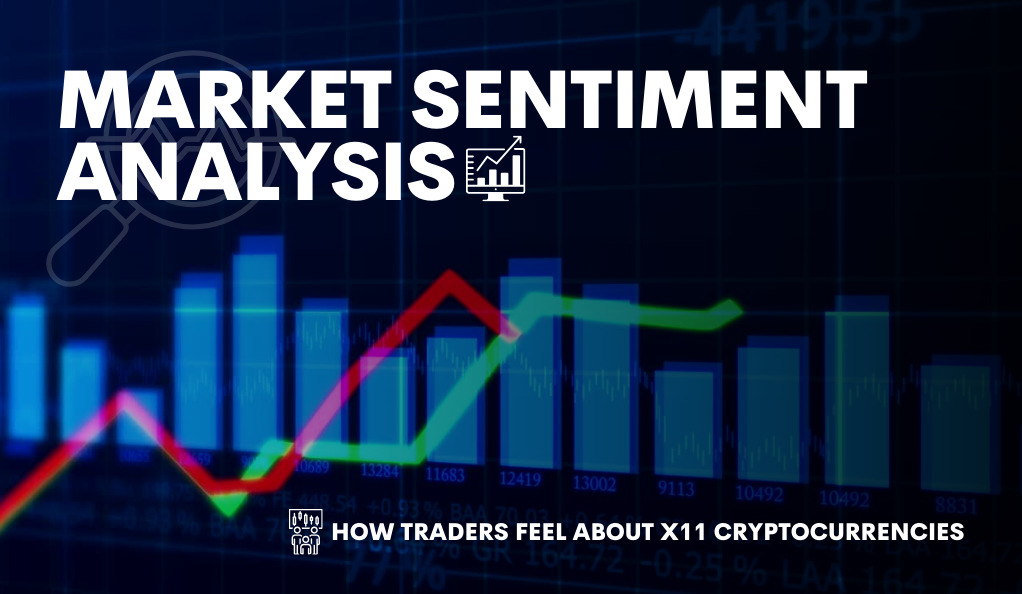Market sentiment analysis, often referred to as opinion mining or emotion AI, is a powerful tool that traders and investors use to gauge the collective feelings and attitudes of market participants towards a particular asset or investment. In the world of finance, understanding market sentiment is crucial as it can provide insights into potential market movements, helping traders make informed decisions.
What is Market Sentiment Analysis?
At its core, market sentiment analysis is the process of determining whether the mood of the market is bullish (positive), bearish (negative), or neutral. This is achieved by analyzing vast amounts of data, including news articles, social media posts, and other public communications, to extract and quantify subjective information.
Why is it Important in Cryptocurrency Trading?
The cryptocurrency market, known for its volatility, is heavily influenced by public perception and sentiment. Unlike traditional markets, where fundamentals like earnings reports or economic indicators play a significant role, cryptocurrencies often move based on news, public perception, and sentiment. For instance, a single tweet from a prominent figure can send the price of a cryptocurrency soaring or plummeting.
Given the decentralized nature of cryptocurrencies, there’s a lack of centralized information sources. This makes sentiment analysis even more vital for traders. By understanding the prevailing sentiment, traders can anticipate potential price movements and adjust their strategies accordingly.
The Role of Technology in Sentiment Analysis
With the advent of advanced natural language processing (NLP) techniques and machine learning algorithms, the process of sentiment analysis has become increasingly automated. These technologies can sift through vast amounts of data at incredible speeds, identifying patterns and sentiments that would be impossible for humans to analyze manually. As a result, real-time sentiment analysis tools are now available, offering traders up-to-the-minute insights into market sentiment.
Understanding X11 Cryptocurrencies
Cryptocurrencies have evolved rapidly since the inception of Bitcoin in 2009. Among the myriad of algorithms and technologies that have emerged, the X11 algorithm stands out as a significant innovation in the crypto space. This section delves deep into the world of X11 cryptocurrencies, shedding light on their unique features and the benefits they offer.
What are X11 Cryptocurrencies?
X11 is a cryptographic algorithm used by several cryptocurrencies. It was introduced by Evan Duffield with the launch of Dash (formerly known as Darkcoin) in January 2014. Unlike Bitcoin, which uses a single hash function (SHA-256), X11 uses a sequence of eleven scientific hashing algorithms. This unique approach offers enhanced security and more efficient mining processes.
Key Features of X11 Cryptocurrencies:

- Enhanced Security: The use of eleven hashing functions increases the security of X11 cryptocurrencies. Even if one or several of these algorithms were to be compromised, the remaining functions would still provide a robust security layer.
- Energy Efficiency: X11 is known for its energy efficiency, especially when compared to other algorithms like SHA-256. This translates to lower electricity costs for miners and a smaller environmental footprint.
- ASIC Resistance: Initially, X11 was designed to resist the development of Application-Specific Integrated Circuits (ASICs) for mining, ensuring a more decentralized mining process. However, over time, ASICs for X11 have been developed, but the algorithm still offers a more level playing field compared to others.
- Quick Adjustments: X11 cryptocurrencies often feature the capability to adjust mining difficulties rapidly. This ensures consistent block generation times, even if there’s a sudden increase or decrease in network hashing power.
- Smooth Mining Experience: Due to its design, X11 provides a smoother mining experience, reducing the wear and tear on hardware components.
Benefits of X11 Cryptocurrencies
In the diverse world of cryptocurrencies, X11 coins offer a unique set of benefits that set them apart. For investors, X11 cryptocurrencies present an opportunity for diversification, allowing them to venture beyond mainstream algorithms and potentially hedge against market volatility. A standout feature of X11 coins, like Dash, is their active and vibrant communities. The support and enthusiasm of these communities can drive innovation, foster adoption, and ultimately enhance the coin’s value. Furthermore, X11 cryptocurrencies often come equipped with innovative features. For instance, Dash introduced the groundbreaking concept of masternodes, which play a pivotal role in transaction anonymization and facilitating instant transactions. These combined attributes make X11 cryptocurrencies an attractive proposition for both miners and investors.
Methods of Sentiment Analysis in Cryptocurrency
Sentiment analysis, especially in the dynamic world of cryptocurrencies, requires a blend of techniques to accurately capture the mood of market participants. Given the vast amount of data available, from tweets to news articles, various methods have been developed to analyze and interpret this information. This section delves into the primary techniques used in sentiment analysis for cryptocurrencies.
Knowledge-Based Techniques
Knowledge-based techniques rely on predefined lists of words and phrases, often referred to as lexicons, to determine sentiment. Each word in the lexicon is assigned a sentiment score, which can be positive, negative, or neutral.
- Advantages: Quick and straightforward, especially for well-defined lexicons.
- Challenges: Limited by the predefined list. New slang or jargon, especially common in the crypto community, might not be recognized.
Statistical Methods
Statistical methods, often machine learning-based, involve training a model on a labeled dataset. Once trained, the model can predict the sentiment of new, unlabeled data.
- Types of Models:
- Linear Regression: Predicts sentiment score based on word frequencies.
- Support Vector Machines (SVM): Classifies data into positive, negative, or neutral categories.
- Neural Networks: Complex models that can capture intricate patterns in data.
- Advantages: Can be highly accurate with a well-trained model.
- Challenges: Requires a substantial amount of labeled data for training. The accuracy is dependent on the quality of the training data.
Hybrid Approaches
Hybrid approaches combine knowledge-based and statistical methods to leverage the strengths of both techniques.
- Example: A system might use a lexicon to quickly filter data and then apply a machine learning model for a more in-depth analysis.
- Advantages: Combines the speed of lexicon-based methods with the accuracy of statistical models.
- Challenges: Can be complex to implement and requires maintenance of both the lexicon and the machine learning model.
| Tool Name | Method Used | Features |
|---|---|---|
| CryptoMood | Hybrid | Real-time sentiment analysis, AI-driven insights |
| The TIE | Statistical | Analyzes tweets, news, and other sources for sentiment |
| Sentiment.io | Knowledge-Based | Uses a vast lexicon tailored for the crypto community |
Challenges in Analyzing Cryptocurrency Sentiments
The world of cryptocurrency is vast, dynamic, and ever-evolving. While sentiment analysis offers invaluable insights into the mood of market participants, it’s not without its challenges. This section delves into the primary obstacles faced when analyzing sentiments in the cryptocurrency domain.
Cultural and Linguistic Nuances
Cryptocurrency has captivated a global audience, drawing enthusiasts and traders from diverse backgrounds, each bringing their unique languages, slang, and cultural nuances. For instance, while the term “bull” signifies a positive sentiment in Western cultures, referencing a “bull market,” it might resonate differently in other cultures. The challenge for sentiment analysis tools is to accurately capture and interpret these varied nuances across a multitude of languages and cultural contexts.
Short Text Strings and Microblogging Challenges
Platforms such as Twitter, where users convey their thoughts in brief messages, present challenges due to the concise nature of the content. For instance, cryptic terms like “HODL” or “moon” carry specific connotations within the crypto community. The challenge emerges in extracting sentiment from these succinct messages, especially when they’re laden with crypto-specific jargon and limited contextual clues.
The Role of Anonymous Platforms
Cryptocurrency conversations frequently occur on anonymous platforms such as Reddit or 4chan. This anonymity can lead to more extreme or polarized posts, posing a challenge in distinguishing authentic sentiments from mere noise or potential manipulative efforts.
Highly Technical Discussions
Cryptocurrency discussions often delve into technical aspects, from blockchain intricacies to algorithm modifications and cryptographic methods. A challenge arises in distinguishing neutral technical dialogues from sentiment-driven ones. For instance, a critique of a technical flaw might not imply a broader negative sentiment towards the cryptocurrency.
Rapidly Changing Sentiments
The cryptocurrency market’s hallmark is its volatility, with sentiments swiftly shifting in response to news, regulatory updates, or market dynamics. The inherent challenge is guaranteeing that sentiment analysis is conducted in real-time or near-real-time. Any delay in analysis could lead to insights that are outdated or no longer pertinent.
Potential for Bots and Manipulation
With the lure of significant profits in the cryptocurrency realm, sentiment manipulation through bots or coordinated efforts is not uncommon. The challenge lies in differentiating authentic sentiments from those that are artificially crafted or magnified, necessitating advanced algorithms and continuous oversight.
The Current Sentiment on X11 Cryptocurrencies

The cryptocurrency landscape is vast, with over thousands of tokens and coins vying for attention. Among these, X11 cryptocurrencies, led by the likes of Dash, have carved a niche for themselves. But what is the prevailing sentiment towards these X11 coins? This section delves into the current mood of the market regarding X11 cryptocurrencies.
Positive Sentiments and Reasons
- Innovative Technology: The X11 algorithm, with its chain of eleven hashing functions, is often lauded for its security and efficiency. This unique approach has garnered appreciation from tech enthusiasts and crypto experts alike.
- Eco-friendly Mining: X11’s energy-efficient mining process is a significant draw, especially in today’s environment-conscious world. Many laud X11 coins for their reduced carbon footprint compared to other cryptocurrencies.
- Active Development: Coins like Dash have active development teams, regularly rolling out updates, enhancements, and new features. This proactive approach has earned them a positive reputation in the community.
Negative Sentiments and Concerns
Despite the promise and unique features of X11 cryptocurrencies, they face several challenges that can influence market sentiment. Like all digital assets, X11 coins are susceptible to market volatility. Their prices can fluctuate dramatically, often leading to negative perceptions, especially among traders with a short-term focus. Adding to the complexity is the ever-changing regulatory environment for cryptocurrencies. Any adverse news or regulatory actions can cast a shadow on the perception of X11 coins, causing apprehension among potential investors. Furthermore, the crypto landscape is rapidly evolving, with new coins and innovative technologies emerging regularly. This intense competition raises concerns about the long-term viability and market standing of X11 cryptocurrencies.
Neutral Perspectives
- Wait-and-Watch Approach: Given the dynamic nature of the crypto market, many adopt a neutral stance, waiting for clearer trends to emerge before forming an opinion.
- Balanced View: Some believe that while X11 coins have their strengths, they also have areas that need improvement. This balanced perspective prevents them from swinging too far on the positive or negative sentiment spectrum.
| Tool Name | Sentiment | Remarks |
|---|---|---|
| CryptoMood | Neutral | Recent updates from Dash have been well-received, but market volatility has kept the sentiment neutral. |
| The TIE | Positive | Positive chatter around X11’s eco-friendly mining is driving a bullish sentiment. |
| Sentiment.io | Negative | Concerns about regulatory challenges have led to a slightly bearish sentiment in recent weeks. |
Impact of Sentiment Analysis on Trading Strategies
In the fast-paced world of cryptocurrency trading, having an edge can make all the difference. Sentiment analysis, with its ability to gauge the mood of market participants, offers traders a unique perspective. But how does sentiment analysis influence trading strategies? This section explores the symbiotic relationship between market sentiment and trading tactics.
How Traders Use Sentiment Analysis
- Informed Decision Making: By understanding the prevailing market sentiment, traders can make more informed decisions, whether it’s entering a position, holding, or exiting.
- Risk Management: A sudden negative sentiment can indicate potential market downturns. Traders can use this information to set stop-loss orders or hedge their positions.
- Spotting Opportunities: Positive sentiment around a particular cryptocurrency can indicate potential bullish trends. Traders can capitalize on this by entering long positions or increasing their holdings.
- Avoiding FOMO (Fear of Missing Out): By objectively analyzing market sentiment, traders can avoid making impulsive decisions driven by FOMO.
The Limitations of Sentiment-Based Trading
While sentiment analysis offers valuable insights, it’s essential to understand its limitations:
- Not a Silver Bullet: Sentiment analysis should be one of many tools in a trader’s arsenal. Relying solely on sentiment can be risky, as other factors like fundamentals and technical indicators also play crucial roles.
- Potential for False Positives: Sentiment can be influenced by orchestrated campaigns or bots. Traders need to ensure they’re basing their decisions on genuine sentiment and not artificially created noise.
Future Trends in Cryptocurrency Sentiment Analysis
The realm of sentiment analysis, especially in the context of cryptocurrencies, is continuously evolving. As technology advances and the crypto market matures, new trends and innovations are emerging that promise to reshape the landscape of sentiment analysis. This section delves into the anticipated future trends in cryptocurrency sentiment analysis.
The Rise of Deep Learning and AI in Sentiment Analysis
- Neural Networks and Beyond: Traditional sentiment analysis techniques are giving way to more advanced neural network models, which can capture intricate patterns in data and offer more accurate sentiment predictions.
- Transfer Learning: With transfer learning, models trained on one task can be fine-tuned for another, allowing sentiment analysis tools to leverage vast amounts of data from related domains for better accuracy.
- Real-time Analysis: Advanced AI models are becoming capable of analyzing vast streams of data in real-time, offering traders up-to-the-minute insights into market sentiment.
Predicting Market Movements Based on Sentiment

In the realm of sentiment analysis, there’s a growing emphasis on predicting market movements based on prevailing sentiments. Rather than merely assessing the current mood, advanced tools of the future are poised to leverage predictive analytics. These tools aim to forecast how sentiments might evolve in the upcoming period, offering traders a more anticipatory perspective on market trends. Additionally, the integration of correlation analysis is gaining traction. By juxtaposing sentiment data with historical price patterns, sophisticated AI tools are venturing into the territory of predicting how shifts in sentiment could directly impact future price trajectories.
Integration of Multiple Data Sources
- Beyond Text: Future sentiment analysis tools might incorporate non-textual data, such as audio from podcasts, video content, or even sentiment derived from images and memes related to cryptocurrencies.
- Holistic Analysis: By integrating data from news articles, social media, forums, and even private chat groups, sentiment analysis tools can offer a more comprehensive view of market sentiment.
Enhanced Personalization for Traders
The future of sentiment analysis is leaning towards offering enhanced personalization tailored to individual traders. As the tools evolve, traders can expect to receive insights specifically curated to align with their portfolio, trading style, and particular areas of interest, ensuring that the information they receive is of utmost relevance. Beyond just tailored insights, the next frontier in sentiment analysis is adaptive learning. Modern tools are being designed to learn and adapt from a trader’s historical decisions and feedback. This continuous refinement means that traders will benefit from insights that are not only personalized but also evolve in tandem with their trading journey.
Addressing the Challenge of Manipulation
- Detection of Bots and Fake Sentiments: Advanced algorithms will be developed to detect and filter out sentiments generated by bots or orchestrated campaigns, ensuring that traders receive genuine insights.
- Trustworthiness Scores: Sentiment analysis tools might assign trustworthiness scores to sources, helping traders discern the reliability of the sentiment data.
Conclusion
The world of cryptocurrency, with its intricate blend of technology, finance, and human emotion, places sentiment analysis at its core, offering a unique lens into the market’s collective psyche. X11 cryptocurrencies, characterized by their distinct algorithmic features, have etched a significant mark in the crypto landscape. Their combination of security, energy efficiency, and innovation, coupled with the power of sentiment analysis, provides traders with invaluable insights. As methods of sentiment analysis evolve from traditional knowledge-based techniques to advanced AI-driven models, the crypto domain stands on the brink of a transformative era.
Looking ahead, the fusion of deep learning, AI, and integrated data sources promises a future where sentiment analysis not only captures the current mood but also anticipates forthcoming shifts. For traders, this means more refined, timely, and actionable insights. However, it’s crucial to remember that sentiment analysis is but one tool in a trader’s arsenal. Success in the volatile crypto market demands a holistic approach, merging sentiment insights with fundamentals, technical analysis, and thorough market research. As the crypto world continues its rapid evolution, sentiment analysis will undoubtedly play an ever-growing role, guiding traders through the exhilarating journey of digital assets.
At axerunners.com, our goal is to furnish well-rounded and trustworthy information regarding cryptocurrency, finance, trading, and stocks. Nonetheless, we avoid providing financial advice and instead encourage users to conduct their own research and meticulous verification.
Read More













